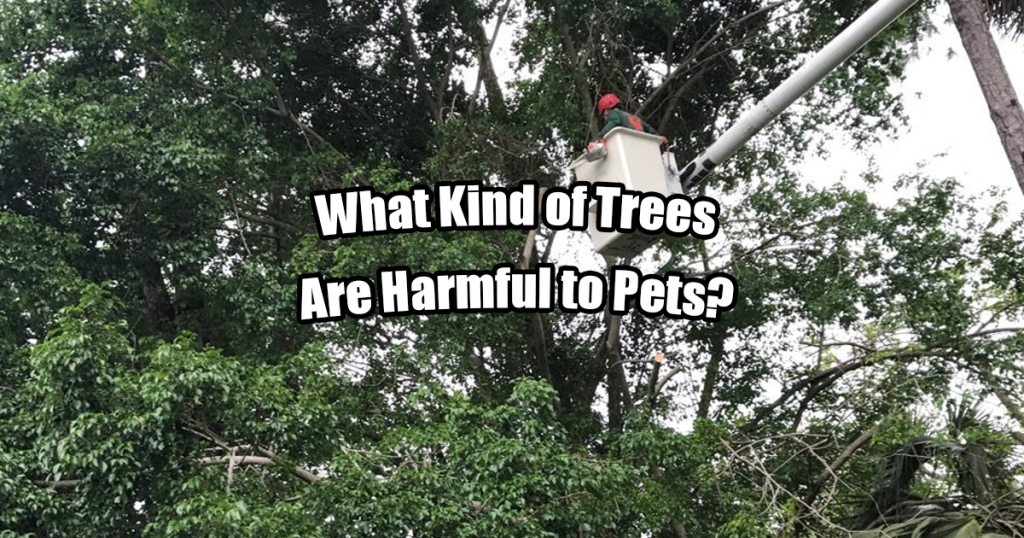
Trees are beautiful additions to any garden and they do wonders for the environment and local ecosystem. While that is true, however, it’s also true that trees can cause a number of problems for homeowners.
Trees can cast a lot of shade over your garden, they can risk causing damage if they fall over, and they might even cause property damage in the meantime if they are growing too close to a fence or a wall.
But another consideration that many people don’t realize, is that trees can be harmful to pets!
No, we’re not just talking about cats getting stuck in trees! (Although that is a legitimate concern if you have an adventurous kitty!) Rather, we’re talking about trees that can cause harm due to poisonous fruit, or due to allergens. Let’s take a look at some of the trees that are most harmful to pets, and whether you should consider taking yours down.
Trees That Can Be Toxic
One type of tree that can be toxic to pets is the Mimosa. This is a truly beautiful tree to look at, but the seedpods are actually very poisonous. This part of the tree is harmful for neurotransmitter production – neurotransmitters being the chemicals that allow the nerves and brain cells to communicate. If a pet should eat one of these seedpods, then they might experience muscle tremors, spasms, convulsions, and a host of other unpleasant symptoms.
The worst part is that these trees can be tempting. That’s because of the blossoms, which look feathery, fluffy, and colorful. This lures unsuspecting pets into thinking they can eat the trees, which is potentially fatal.
And of course, if you have young children, then they also need to be protected from eating these harmful seeds.
Another potentially harmful tree is the boxwood. This is an attractive evergreen tree that is popular at least in part thanks to its vibrant red berries. Those same berries however are actually very dangerous. These contain a chemical that is actually metabolized into cyanide once ingested! That means that the body converts the substance into cyanide – the highly poisonous chemical that is seen in spy films – once it has been eaten.
But what might surprise you, is that even the seemingly safe options like fruit trees can be harmful to pets. The reason for this is that the actual seeds and core can also contain a substance that turns to cyanide once it is ingested.
Even oak trees can be harmful. That’s because the acorns contain a toxic element that is called tannic acid. Once ingested, this leads to vomiting, diarrhea, and stomach pain. Of course, acorns can also present a choking hazard and this is another consideration to bear in mind if you have young children.
Red maple is an interesting one because it’s actually unknown what makes it toxic! However, if a cat, dog, or even horse should consume the leaves, this can harm the function of red blood cells. This can result in changes in urine color, loss of appetite, dark eyes and mouth, and severe lethargy. This is actually most pronounced in horses.
Black walnuts are occasionally dangerous due to a type of mold that often grows on the nut. The nuts are toxic for horses and dogs but thought to be okay for cats. Should horses or dogs consume the nuts, then mold can cause fluid retention in the legs, increased heart rate, and increased respiration. This can also lead to changes in body temperature and more, and can ultimately be very dangerous for your pets.
Not sure if your tree is one of these? Call us so we can help you find out!
Allergies
While not all trees are toxic, that doesn’t necessarily make them safe! Trees can still cause harm in other ways and one of the most common is allergy. If your pet has an allergic reaction to pollen then you may notice that they are coughing, sneezing, wheezing, and generally acting tired. We tend to think of our pets as the cause of allergies – but they can be susceptible to them as well!
When an animal breathes in an allergen, it’s body will mistake that substance for a toxin or other harmful exogenous agent. As a result, this will trigger an immune response as the body attempts to remove that substance from the system. This is what causes swelling, reddening, tearing, and more. And all these factors combined are what can be very unpleasant for your pet.
Keep in mind though, that there are many more causes for these symptoms. These causes include the likes of mold, asthma, or unrelated breathing difficulties. You can speak with your vet in order to ascertain the precise cause before you get to work cutting the thing down!
What Can You Do About Harmful Trees?
If you believe that a tree is causing your pet health issues, or you discover that it is potentially toxic, it is important to deal with that issue by removing the tree.
There are many ways to remove a tree. One of the simplest is to call a professional tree removal company. They will then come and chop down the tree for you before removing the remains. This is a very quick, easy, and hassle-free way to solve the issue. We recommend this option in most cases, as it includes the minimal risk of injury or other problems.
If the tree is under 6’, then you may decide to remove the tree yourself. We have posts on this site that will help you understand how to do this. However, the basic process involves removing the tree one piece at a time, starting at the top and then moving down the trunk in chunks. You shouldn’t cut entirely through the tree in one go, but should rather cut most of the way using a slanted angle in order to guide the trajectory of the fall. Once you’ve gotten most of the way through the trunk, you should then apply pressure to remove the final piece from a distance. You can do this by wrapping a cord or rope around the trunk and then pulling on it. You should hear a crack when the final piece attaching the two snaps. This is when you will have removed that portion of the tree.
There are a few things to consider when going this route. The first is that you should invest in a high quality chainsaw, handsaw, or alligator saw (there are other tools that can do the job, too). The sharper and more powerful the tool, the easier the job will be. This actually reduces the risk of injuries. At the same time, you should also aim to invest in a pair of protective goggles to protect your eyes from woodchippings and other pieces of debris. Likewise, it’s important to wear thick leather gloves. While these can’t protect you from a saw, they will be able to reduce the impact of an injury and also protect you from other painful experiences (like a branch piercing your skin). You should likewise choose appropriate protective footwear and outer layers to keep you warm and protected.
Finally, make sure that you have someone on hand to help during the process. They can not only help you to get the job done quicker but they will also be able to call for help and offer assistance in the unlikely event that something does go wrong.
Think too about how to dispose of the tree once it has been taken down. This is another potential advantage of using a professional service: as that will often be included in the cost.
When it comes to dealing with harmful trees there is not a one size fits all option. We have tons of different services available to help you.
Some More Considerations
You do not need a permit in most areas to remove a tree, however you should always check the local rules and regulations in your given city/down/jurisdiction. Likewise, you should discuss the job with any neighbors that might be affected: whether it is likely to affect their view, or whether there is a chance of the tree falling on their property once cut down.
You may find that there are more things you need to consider if the tree is not entirely on your property. For example, if the tree is hanging over your garden and dropping seeds and fruits into your property, then you may need to discuss with the owner before it can be cut down. Likewise, if the tree that is being cut is on commercial property, then you definitely need to cut it down. These are all important considerations. Likewise, you may find that the tree is jointly on your property and that of a neighbor.
There are other options if cutting down the tree isn’t doable. For example, simply trimming the tree may be enough if it prevents the seeds from being dropped on your property. Likewise, you may be able to use netting to prevent the seeds from falling onto the ground. Then there is the option of speaking to your vet against using anti-histamines or other options to protect your pet. You can also section off the area around the base of the tree, to prevent the pet from getting to anything harmful.
